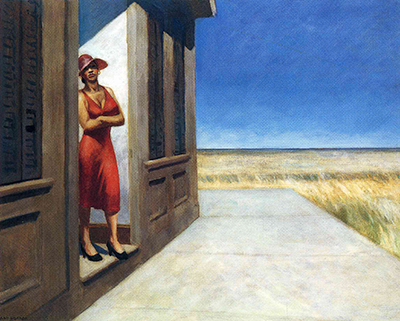Edward Hopper’s oil on canvas painting, Carolina Morning, illustrates the alluring presence of a woman lost in vast plains extended to the ocean. The realist technique that Hopper integrated within his work is based on his personal interpretation of images in a creative rendition.
The inspiration behind the piece arose from a trip Hopper and his wife took in April 1929 to the countryside of Charleston, South Carolina. Upon exploring the endless landscape, the couple encountered a beautiful women standing on her porch staring into the horizon. The women had rushed back inside upon the arrival of her husband, yet had captured the attention of Hopper.
The artist had revisited the event in later year of 1955, manifesting the lost event in a new light. The painting depicts an African American women leaning against the entrance of a cabin, on top of a step leading onto a concrete porch. The woman embodies a spontaneous allure to her, alongside a wealthy elegance. The muse wears a red dress to her knees, matched by a lavish red hat and accompanied by black pointed heels.
As the dress cuts into a sharp V, outlining the woman’s breasts, the sexual attire opposed to the fashion of the 1930’s, hints that the women’s clothing within the painting is a re-interpretation of Hopper’s memory. Carolina Morning upraises the emotion of hostility as the women stairs directly at the viewer with arms crossed leaning against the doorway.
The powerful presence of the women provokes the sense of a growing African American transition into wealth and status in the United States. The environment is encompassed by a peaceful atmosphere with warm shades, illustrating the breeze of the vast plains extended to the ocean. However, the plains suggest a relationship to the previous plantations that used to roam the land.
Yet, the ocean at the horizon evokes a sense of freedom as it merges into the sky. The setting of the painting generates an analogy for the tainted history of the nation.
Edward Hopper’s work embodies a sense of realism for the viewer, yet is based on his personal recreation of events. Hopper is not simply an artist, but a creative director, repainting the events of his life to create a transformed memory. Carolina Morning continues to seize attention for decades, as an endless number of questions are left unanswered.




